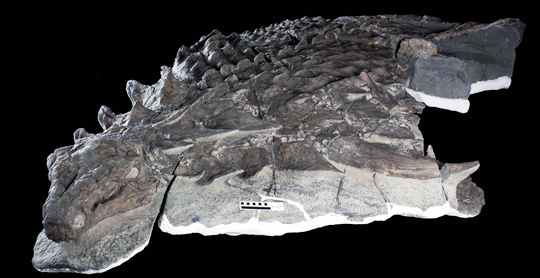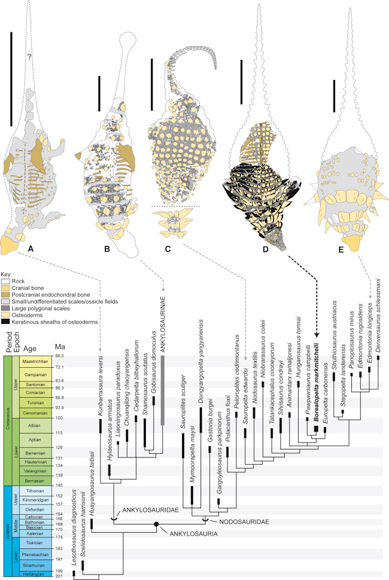Amazing Armoured Dinosaur Fossil Reveals Countershading
Borealopelta markmitchelli – Big but There was Something Bigger and Very Nasty Out There!
You’re about as heavy as a Ford Focus, your body is covered in bony armour and you have lethal spikes running down your flanks, including a pair of wicked-looking shoulder spines, yet you rely on camouflage to help keep you safe. That’s the conclusion reached by an international team of scientists as they have studied the best-preserved armoured dinosaur ever found. Borealopelta might have weighed in excess of 1.3 tonnes and measured more than 5.5 metres long, but it relied on countershading to help hide it from predatory dinosaurs.
Borealopelta – a “Walking Tank”
This is an amazing piece of research, perhaps, more amazingly, this research implies that for a dinosaur described as a “walking tank”, there was one or maybe several super-sized meat-eating dinosaurs that despite the heavy armour, it was best to hide away from. Trouble is, palaeontologists can only speculate about what sort of multi-tonne Theropod might have been the stuff of nightmares for Borealopelta, we simply don’t know.
An Illustration of the Armoured Dinosaur Borealopelta (B. markmitchelli)
Picture credit: Julius Csotonyi
For models and figure of armoured dinosaurs including Borealopelta (whilst stocks last): PNSO Age of Dinosaurs Models.
The First Line of Defence – Not to be Seen in the First Place
Writing in the academic journal “Current Biology”, the researchers, which included Caleb Brown and Donald Henderson (Royal Tyrrell Museum, Alberta, Canada) along with Jakob Vinther (Bristol University), Ian Fletcher (Newcastle University) and colleagues from the Massachusetts Institute of Technology, conclude that Borealopelta possessed countershading to help camouflage it and avoid detection from sharp-eyed Theropod dinosaurs.
Using chemical analysis of organic compounds in the horns and skin to infer the dinosaur’s pigmentation pattern, the scientists found that the skin exhibited countershading, a common form of camouflage in which an animal’s underside is lighter than its back. The top part of the animal was coloured a reddish-brown. The russet colouration contrasted with the lighter shaded, paler underbelly.
Dr Vinther, an expert on the detection of colour signals within the fossil record commented:
“We found a lot of sulphur bearing organic compounds, which we later could confirm was evidence for reddish brown colouration.”
The Superbly-Preserved Holotype Specimen of Borealopelta markmitchelli
Picture credit: Royal Tyrrell Museum
A Sleeping Armoured Giant
The researchers used two mass spectroscopic techniques called Time of Flight Secondary Ion Mass Spectroscopy and Pyrolysis Gas Chromatography Mass Spectroscopy to reveal the armoured dinosaurs’ colouration. Such procedures were only possible due to the exceptional preservation of the specimen, which is currently on display at the Royal Tyrrell Museum. The fossil material was discovered in 2011 at the Suncor Millennium Mine, in north-eastern Alberta, during the removal of overburden. This was the first dinosaur to be found in these sediments.
To read more about the fossil discovery: Oil Worker Digs Up Dinosaur.
The strata represent sediments laid down in an offshore marine environment. The carcass sank to the bottom of the seabed, its back hitting the seafloor hard enough to deform the underlying sedimentary layers. The specimen was preserved in exquisite detail and is almost complete. The articulated skeleton gives the impression that this armoured giant is merely sleeping and likely to be roused at any moment.
Holotype Specimen of B. markmitchelli
Picture credit: Royal Tyrrell Museum
The Implications of the Countershading
Borealopelta comes from the Wabiskaw Member of the Clearwater Formation, these rocks were laid down in the Early Cretaceous (Albian faunal stage). Marine reptiles are known from these rocks, but this is the first time that a dinosaur has been found, the body of Borealopelta probably floated out to sea, an example of “bloat and float”. The discovery of countershading in such a large animal begs the question, what sort of dinosaur was Borealopelta trying to hide from?
Countershading is a common evolutionary strategy seen in many prey animals today. However, no extant animal exceeding one tonne in weight is counter shaded. Lots of ungulates possess countershading but they are all far smaller than Borealopelta.
The researchers assessed the body mass of typical mammals that have such camouflage and compared them to the body weights of the carnivorous mammals that predate them. The scientists concluded that as prey body size increases within typical terrestrial mammalian prey, so the number of species demonstrating countershading decreases. Once you get to be the size of a rhino or an elephant, countershading in extant, terrestrial ecosystems is not present. However, in the Early Cretaceous, things were very different.
A Chart Illustrating the Loss of Countershading as Body Mass Increases (Terrestrial Mammals)
Picture credit: Current Biology
The chart above shows the relative proportion of species that exhibit countershading. The diagonally hatched area represents the mass above which significant predation of adults does not occur. Animals illustrated above the chart are representative taxa within each mass bin, the species names in italics at the top indicates the body masses of the largest carnivores (Canivora).
Dr Vinther explains:
“Although countershading is common, our findings come as surprise because Borealopelta’s size far exceeds that of counter shaded animals alive today. It suggests the dinosaur was under enough pressure from predators to select for concealment. This means that the Cretaceous period was a really scary time to be around in. Large theropod dinosaurs with excellent colour vision would have made life stressful for many a dinosaur, both big and small.”
What was Borealopelta trying to Hide from?
As no other dinosaur remains have been found in the Wabiskaw Member, the large, meat-eating dinosaurs Borealopelta tried to hide from can only be speculated. Huge theropod footprints found in rocks of a similar age and nearby formations in northern Alberta and British Columbia can hint at what sort of fearsome creature shared Borealopelta’s world. For example, substantial, three-toed dinosaur tracks from the Cedar Mountain Formation of eastern Utah have been described and assigned to the ichnogenus Irenesauripis.
Some of these tracks are nearly ninety centimetres in length and the huge claw marks indicate that whatever dinosaur made these tracks, it was a formidable predator. The authors of this study suggest that the apex predators were probably allosaurid/carcharodontosaurid taxa and suggest something like the twelve-metre-long Acrocanthosaurus, fossils of which are found in similarly-aged formations further south.
An Illustration of an Acrocanthosaurus (A. atokensis)
The image (above) shows an Acrocanthosaurus dinosaur model in the Papo model range.
To view this range: Papo Dinosaur and Prehistoric Animal Models.
Heavily armoured dinosaurs were camouflaged to avoid being spotted by a predator, but what sort of predator is open to question. Perhaps, in a remote part of British Columbia, the fossil remains of an entirely new type of theropod dinosaur are awaiting discovery…
“Northern Shield” and 7,000 Hours of Painstaking Work
The genus name means “northern shield” a reference to the latitude of the fossil discovery, whereas, the species name honours museum technician Mark Mitchell who spent more than 7,000 hours carefully removing the fossil from the surrounding rock, one grain at a time. Researchers are now examining the preserved gut contents to find out the nature of its last meal, and working to characterise the body armour in even greater detail.
Comparing Borealopelta to Other Well-Preserved Ankylosaurs
Picture credit: Current Biology
The picture above shows a time-calibrated strict consensus tree showing the position of Borealopelta markmitchelli within the Ankylosauria, with representative well-preserved Ankylosaurs provided for comparison. In this analysis, Borealopelta is regarded as the sister taxon of Pawpawsaurus, also from the Albian faunal stage of the Cretaceous.
Scale bar = 1 metre
(A) Kunbarrasaurus, (QM F18101).
(B) Euoplocephalus, (NHMUK 5161).
(C) Sauropelta, (AMNH 3035 and (3036 composite).
(D) Borealopelta, (TMP 2011.033.0001)
(E) Edmontonia, (AMNH 5665).
The scientific paper: “An Exceptionally Preserved Three-Dimensional Armoured Dinosaur Reveals Insights into Coloration and Cretaceous Predator-Prey Dynamics” by Caleb M. Brown, Donald M. Henderson, Jakob Vinther, Ian Fletcher, Ainara Sistiaga, Jorsua Herrera and Roger E. Summons published in Current Biology.
To read an article on an earlier study regarding the counter-shading of Psittacosaurus: Calculating the Countershading of Psittacosaurus.
Visit the Everything Dinosaur website: Everything Dinosaur.







